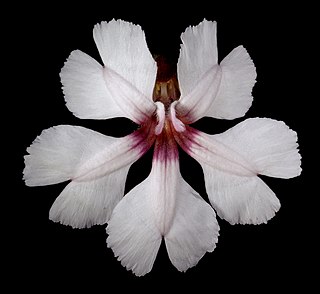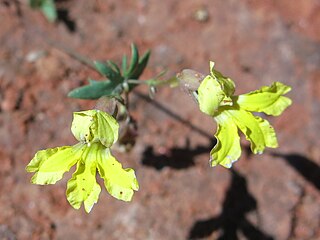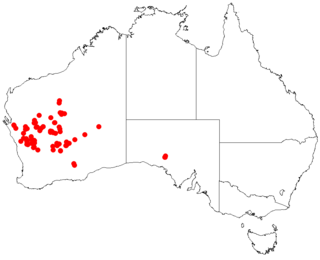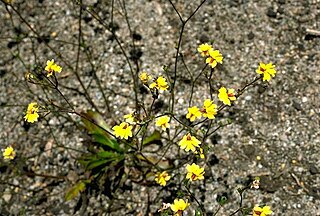
Goodenia montana, commonly known as mountain velleia, is a flowering plant in the family Goodeniaceae. It is a small, perennial herb with lance-shaped to egg-shaped leaves with the narrower end towards the base, and yellow flowers. It mainly grows in woodland and sub-alpine grasslands in New South Wales, Victoria and Tasmania.

Goodenia paradoxa, commonly known as spur velleia or spur goodenia, is a species of flowering plant in the family Goodeniaceae, and is endemic to Australia. It is a perennial herb covered with soft hairs, and has egg-shaped to elliptic leaves with toothed edges and yellow flowers on an ascending flowering stem.

Goodenia caroliniana is a species of flowering plant in the family Goodeniaceae, and is endemic to eastern Australia. It is a perennial herb with egg-shaped to lance-shaped leaves with toothed edges and the narrower end toward the base, and erect flowering stems up to 50 cm (20 in) high and yellow flowers.

Goodenia rosea, commonly known as pink velleia, is a species in the family Goodeniaceae and is endemic to inland areas of Western Australia. It is a perennial herb with lance-shaped to toothed or pinnatisect leaves, pink, lilac or white flowers on an ascending flower stem, and compressed fruit.

Goodenia connata, commonly known as cup velleia, is a species of flowering plant in the family Goodeniaceae, and is found in all mainland states and territories of Australia. It is a glabrous annual herb with a rosette of leaves at the base, and ascending flowering stems with yellow, brownish-yellow or white flowers, often with mauve markings.

Goodenia glabrata, commonly known as pee the bed, is a species of flowering plant in the family Goodeniaceae and is native to mainland Australia. It is a mostly glabrous annual herb with ascending flowering stems, oblong to lance-shaped leaves with toothed edges, and yellow flowers.
Goodenia lancifolia, commonly known as scruffy goodenia, is a species of flowering plant in the family Goodeniaceae and is endemic to the far south-west corner of Western Australia. It is a perennial herb with linear to narrow egg-shaped at the base and stem-clasping, lance-shaped to egg-shaped stem-leaves and blue flowers with a white centre.

Goodenia pusilliflora, commonly known as small-flower goodenia, is a species of flowering plant in the family Goodeniaceae and is endemic to drier parts of southern Australia. It is a low-lying to ascending herb with oblong to egg-shaped leaves with toothed or lyrate edges, and racemes of small yellow flowers.

Goodenia mystrophylla is a flowering plant in the family Goodeniaceae and is native to eastern Australia and New Guinea. It is a small, perennial herb with lance-shaped leaves, prostrate or low-lying flower stems and yellow flowers with purplish markings.

Goodenia arguta, commonly known as spur velleia, or grassland goodenia, is a species of flowering plant in the family Goodeniaceae and endemic to continental Australia. It is a glabrous perennial with a rosette of leaves at the base of the plant and ascending flowering stems with deep yellow flowers.

Goodenia daviesii, commonly known as hairy velleia, is a species of flowering plant in the Goodeniaceae family and is endemic to inland areas of Western Australia. It is an annual herb with lyre-shaped, pinnatifid leaves and lilac to white flowers.

Goodenia discophora, commonly known as cabbage poison, is a species of flowering plant in the Goodeniaceae family and is endemic to the south-west of Western Australia. It is a herb with lyre-shaped, pinnatifid leaves and yellow flowers.

Goodenia brendannarum is a species of flowering plant in the family Goodeniaceae, and is endemic to a small area in the south-west of Western Australia. It is a perennial herb with woody stems, crowded, narrowly egg-shaped leaves with toothed edges, and erect flowering stems and orange-yellow and red flowers.

Goodenia capillosa, commonly known as hispid velleia, is a species of flowering plant in the family Goodeniaceae and is native to inland areas of Western Australia and South Australia. It is an annual herb with covered with soft hairs, and has narrowly egg-shaped to narrowly elliptic leaves with toothed or lyre-shaped edges, and yellow flowers.

Goodenia macrocalyx is a species of flowering plant in the family Goodeniaceae and is endemic to north-eastern Australia. It is a glabrous, perennial herb with elliptic to narrowly egg-shaped leaves at the base of the plant, yellow flowers and narrowly oval fruit.

Goodenia panduriformis, commonly known as Pindan poison, is a species of flowering plant in the family Goodeniaceae and is endemic to north-western Australia. It is a glaucous herb with erect flower stems, glabrous, toothed, egg-shaped leaves with the narrower end towards the base, bracteoles joined to form a large disc, and deep- or brownish-yellow flowers.

Goodenia parvisepta is a species of flowering plant in the family Goodeniaceae and is endemic to a small area of New South Wales. It is a glabrous perennial herb with erect flowering stems, lance-shaped leaves with toothed or lobed edges, and yellow flowers.

Goodenia perfoliata is a species of flowering plant in the family Goodeniaceae and is endemic to a small area of New South Wales. It is a mostly glabrous, perennial herb with erect flowering stems, lance-shaped leaves with sometimes deeply-toothed edges, and yellow flowers with bracteoles joined to form a disc-like funnel.

Goodenia trinervis is a species of flowering plant in the family Goodeniaceae and is endemic to the south-west of Western Australia. It is a perennial herb with linear to spoon-shaped leaves at the base of the plant, yellow flowers on an ascending flower stem, and oval fruit.

Goodenia subsolana is a species of flowering plant in the family Goodeniaceae and is endemic to Queensland. It is a perennial herb with toothed, lance-shaped leaves, yellow flowers on an ascending to low-lying flower stem, and more or less spherical fruit containing round to elliptic seeds.




















